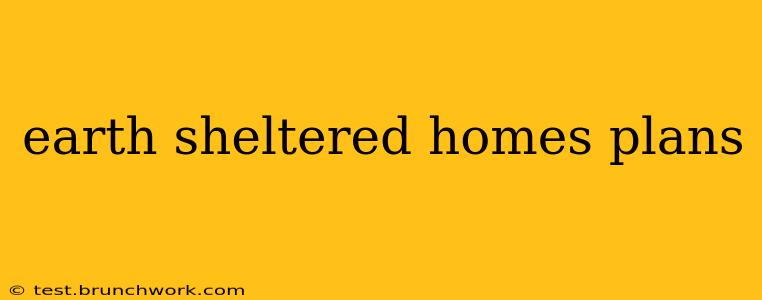Dreaming of a home that's both energy-efficient and uniquely stylish? Earth-sheltered homes, also known as underground homes, offer a compelling blend of sustainable living and architectural ingenuity. This comprehensive guide delves into the world of earth-sheltered home plans, exploring their benefits, challenges, and everything you need to know before embarking on this exciting building project.
The Allure of Earth Sheltered Living: Benefits and Considerations
Earth-sheltered homes are more than just a trend; they represent a thoughtful approach to sustainable design. Let's explore the advantages and potential drawbacks:
Advantages:
- Energy Efficiency: The earth acts as a natural insulator, significantly reducing heating and cooling costs. Temperature fluctuations are minimized, leading to lower energy bills and a smaller carbon footprint. This is a major selling point for environmentally conscious homeowners.
- Durability and Protection: Earth-sheltered homes are incredibly resilient against extreme weather conditions, including hurricanes, tornadoes, and wildfires. The earth provides substantial protection from the elements, resulting in less maintenance and a longer lifespan for the structure.
- Noise Reduction: The earth effectively muffles outside noise, creating a peaceful and quiet living environment. This is a significant benefit for those living in busy or noisy areas.
- Unique Aesthetics: Earth-sheltered homes offer a distinct and often dramatic architectural style. They can seamlessly blend into the landscape, creating a harmonious connection between home and environment. Many designs incorporate natural light creatively, preventing a dark and claustrophobic feel.
Challenges:
- Construction Costs: Building an earth-sheltered home can be more expensive upfront than a traditional above-ground structure. Specialized excavation and engineering expertise are often required.
- Moisture Control: Proper waterproofing and drainage are crucial to prevent moisture problems. Careful planning and execution are vital to avoid issues with mold and mildew.
- Site Selection: Not all locations are suitable for earth-sheltered construction. Geological surveys are essential to assess the suitability of the land. The site must be carefully chosen to ensure proper drainage and structural stability.
- Natural Light: While creative design can mitigate this, incorporating sufficient natural light requires careful planning. Strategically placed windows and skylights are necessary to prevent a dark and gloomy interior.
Types of Earth Sheltered Home Plans
Earth-sheltered homes come in various designs, each with its unique characteristics:
Partially Buried Homes:
These designs incorporate earth berms on one or more sides of the structure, reducing energy consumption and providing insulation. They often retain a more traditional architectural style while benefiting from earth sheltering techniques.
Fully Buried Homes:
These homes are entirely covered with earth, offering maximum insulation and protection. Design is crucial to ensure adequate ventilation and natural light. They often boast a more modern, minimalist aesthetic.
Hybrid Designs:
These innovative plans combine elements of both partially and fully buried homes, offering a tailored solution to specific site conditions and homeowner preferences.
Planning Your Earth Sheltered Home: Essential Steps
Building an earth-sheltered home requires meticulous planning. Key steps include:
1. Site Assessment and Geotechnical Engineering:
Thorough investigation of the site's geology, hydrology, and soil conditions is crucial. A geotechnical engineer can assess the feasibility of the project and identify potential challenges.
2. Architectural Design:
Work with an architect experienced in earth-sheltered design. The design should address natural light, ventilation, moisture control, and structural integrity.
3. Building Permits and Approvals:
Obtain necessary building permits and approvals from local authorities. Regulations concerning earth-sheltered homes may vary depending on your location.
4. Construction Management:
Engage an experienced contractor specializing in earth-sheltered construction. This type of project demands expertise in excavation, waterproofing, and specialized building techniques.
Conclusion: Embracing Sustainable Living
Earth-sheltered homes offer a compelling path toward sustainable living, combining energy efficiency, durability, and unique aesthetics. While there are challenges to consider, careful planning, expert consultation, and a commitment to detail can lead to a rewarding and environmentally responsible home. By understanding the benefits, challenges, and planning steps involved, you can embark on the journey of designing and building your dream earth-sheltered home.
